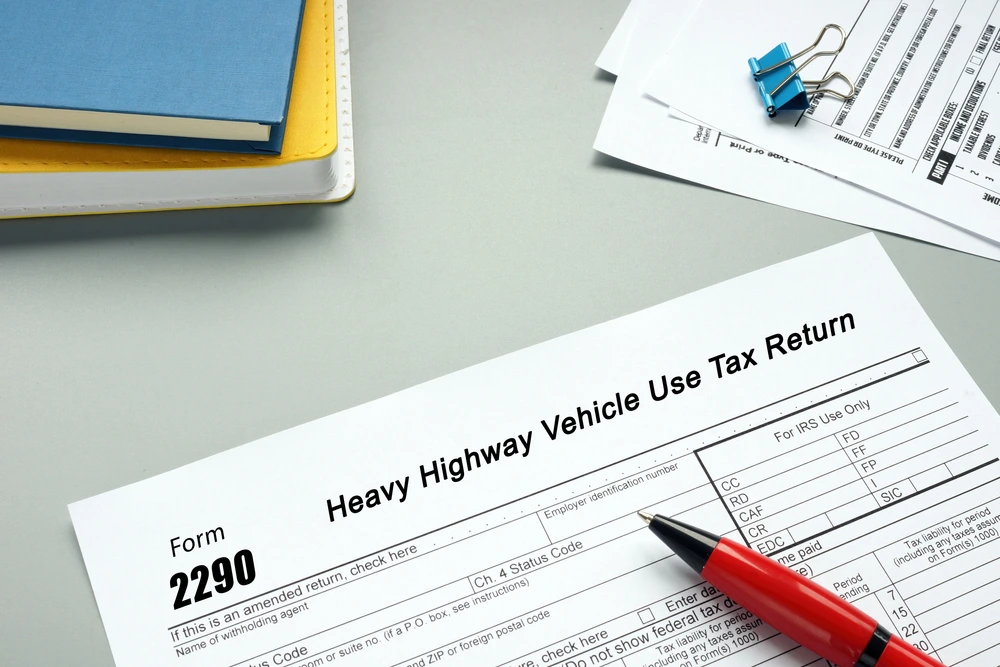Whether you’re a new truck driver, an experienced owner-operator, or managing an entire fleet, understanding truck weight classes is essential for staying compliant and making informed decisions on the road. These classifications—based on a truck’s Gross Vehicle Weight Rating (GVWR)—help determine which vehicles require commercial licenses, how they’re taxed, and what regulations they must follow.
Truck weight classes aren’t just technical jargon—they directly affect vehicle registration, insurance costs, toll rates, road usage permissions, and even federal tax requirements like Form 2290 for Heavy Vehicle Use Tax (HVUT). Misunderstanding your vehicle’s weight class could lead to legal penalties, rejected filings, or costly delays.
This guide breaks down everything you need to know about truck weight classes—from how they’re structured to how they impact your operations—so you can drive smarter, file accurately, and stay compliant with state and federal laws.
What Are Truck Weight Classes?
Truck weight classes are standardized categories that group commercial and non-commercial vehicles based on their Gross Vehicle Weight Rating (GVWR)—the maximum allowable weight of a fully loaded vehicle, including the truck itself, passengers, fuel, cargo, and any attached equipment. These classifications help federal and state agencies, insurance providers, and trucking professionals determine the appropriate regulations, licensing requirements, tax obligations, and road restrictions for each vehicle type.
The main purpose of truck weight classes is to ensure road safety, vehicle compliance, and fair taxation. Different weight classes have different responsibilities and are subject to specific federal and state guidelines. For example, heavier trucks may need commercial driver’s licenses (CDLs), follow strict maintenance rules, and pay Heavy Vehicle Use Tax (HVUT).
Governing Bodies and Regulatory Relevance
Several key organizations and agencies are involved in defining and enforcing truck weight class standards:
- Department of Transportation (DOT): Sets federal regulations and safety standards for vehicles operating on public roads, including weight limits and inspections.
- Federal Motor Carrier Safety Administration (FMCSA): Oversees safety regulations and CDL requirements for commercial vehicles, particularly for trucks over 10,000 lbs GVWR.
- Internal Revenue Service (IRS): Uses truck weight classifications to determine HVUT liability. Trucks with a GVWR of 55,000 pounds or more must file Form 2290 annually.
Understanding how these agencies apply weight classifications can help you avoid penalties, stay compliant, and file taxes correctly.
Gross Vehicle Weight Rating Explained
GVWR is the single most important number when determining a truck’s weight class. It’s not the actual weight of the vehicle at any given time but rather the maximum safe weight the manufacturer allows for the vehicle when fully loaded.
GVWR includes:
- The vehicle’s base weight
- Cargo and equipment
- Passengers
- Fuel and fluids
- Any trailers attached, depending on the configuration
You can usually find the GVWR on a label located inside the driver’s side door frame or in the vehicle’s manual. Manufacturers determine GVWR based on factors like frame strength, axle load capacity, brakes, suspension, and more.
Overview of U.S. Truck Weight Classes
In the United States, trucks are categorized into eight official weight classes based on their Gross Vehicle Weight Rating—the total maximum weight a vehicle can safely carry, including cargo, passengers, and fuel. These classifications help determine what regulations apply to a specific vehicle, including licensing requirements, tax obligations, and compliance standards.
Classes 1 to 3: Light-Duty Trucks
Class 1 trucks have a GVWR of up to 6,000 pounds. These are the smallest trucks on the road and typically include compact pickups, small SUVs, and sedans that may be used for light commercial purposes or personal transportation.
Class 2 includes vehicles with a GVWR between 6,001 and 10,000 pounds. This class covers many full-size pickup trucks like the Ford F-150, cargo vans, and larger SUVs often used by contractors or small businesses.
Class 3 covers trucks with a GVWR between 10,001 and 14,000 pounds. These are considered heavy-duty pickups, such as the Ford F-350, and are often used for towing and hauling larger loads. You’ll also find small box trucks and commercial vans in this class.
Classes 4 to 6: Medium-Duty Trucks
Class 4 trucks range from 14,001 to 16,000 pounds GVWR. Vehicles in this class include step vans, small dump trucks, and medium-sized service vehicles often used for local deliveries or maintenance services.
Class 5 includes trucks weighing between 16,001 and 19,500 pounds. These are often seen as large delivery trucks, bucket trucks, and walk-in vans, frequently used by utility companies and fleet operators.
Class 6 covers trucks with a GVWR of 19,501 to 26,000 pounds. These medium-duty trucks are used for more demanding tasks such as beverage delivery, school transportation, or heavier commercial services. CDL requirements may vary by state for this class, especially when towing is involved.
Classes 7 and 8: Heavy-Duty Trucks
Class 7 trucks weigh between 26,001 and 33,000 pounds GVWR. These include city buses, refuse trucks (garbage trucks), street sweepers, and other large vocational trucks. A Commercial Driver’s License is required to operate vehicles in this class.
Class 8 includes any vehicle with a GVWR over 33,000 pounds. These are the heaviest trucks on the road, such as long-haul tractor-trailers, cement mixers, and heavy-duty dump trucks. These vehicles not only require a CDL, but also fall under additional federal regulations—including Heavy Vehicle Use Tax (HVUT) reporting with Form 2290 if the truck’s weight is 55,000 pounds or more.

Why Truck Weight Classes Matter
Truck weight classes aren’t just a technical classification—they play a critical role in how your vehicle is regulated, taxed, insured, and maintained. Whether you’re behind the wheel or managing a fleet, understanding weight classes can help you stay compliant, avoid penalties, and optimize your operations.
Legal Compliance: DOT Regulations and CDL Requirements
Truck weight classes directly determine what legal standards apply to your vehicle under Department of Transportation and Federal Motor Carrier Safety Administration guidelines. For instance, heavier trucks are required to follow stricter regulations for vehicle inspections, maintenance, and roadside safety checks.
Additionally, your truck’s weight class will dictate whether a Commercial Driver’s License is required. In most states, any truck with a GVWR over 26,000 pounds (typically Class 7 and above) requires a CDL. If you’re towing a trailer that pushes the combined weight higher, even medium-duty trucks (Class 6) might trigger CDL requirements.
Failing to comply with these regulations can result in hefty fines, vehicle impoundment, or even disqualification from driving commercially.
HVUT/Form 2290 Filing: Applies to Vehicles Over 55,000 Pounds
One of the most important tax obligations tied to truck weight classes is the Heavy Vehicle Use Tax, filed using IRS Form 2290. If your vehicle has a GVWR of 55,000 pounds or more and is expected to travel over 5,000 miles annually (or 7,500 miles for agricultural vehicles), you are required to file Form 2290 and pay the HVUT.
Filing requirements and tax amounts are based on the vehicle’s weight category, and failure to file can delay vehicle registration or renewal. With platforms like ExpressTruckTax, drivers and fleets can easily calculate the tax based on weight class, file electronically, and receive a stamped Schedule 1—proof of payment required by the IRS and most DMVs.
Toll Rates and Road Restrictions
Many toll roads, bridges, and tunnels use truck weight class as a factor when determining fees. Heavier trucks pay higher tolls because they contribute more wear and tear on infrastructure. For example, a Class 8 semi-truck may pay significantly more than a Class 3 box truck for the same stretch of highway.
Additionally, local and state authorities often restrict access to certain roads based on truck size and weight. Exceeding posted limits—even unintentionally—can lead to fines or forced detours. Knowing your weight class helps you plan legal, efficient routes and avoid restricted zones or overweight violations.
Insurance and Vehicle Registration
Your truck’s weight class plays a big role in both commercial vehicle insurance rates and registration requirements. Heavier trucks usually require more expensive insurance policies due to increased risk and repair costs. Certain weight classes may also require proof of DOT compliance or additional forms during the registration process.
For example, many states require proof of HVUT payment (Form 2290 Schedule 1) before issuing or renewing registration for vehicles over 55,000 pounds. If your weight class is misreported, you could face delays or even denials in registration.
Fleet Management and Maintenance Planning
For fleet operators, knowing the weight class of each vehicle is essential for maintenance scheduling, driver assignment, fuel management, and cost forecasting. Heavier-duty trucks require more frequent inspections, specialized parts, and different maintenance cycles compared to light-duty vehicles.
Additionally, tracking weight classes across your fleet helps with:
- Assigning CDL-certified drivers to appropriate trucks
- Ensuring compliance with fuel tax reporting (IFTA)
- Budgeting for HVUT filings and toll expenses
- Planning for future vehicle purchases or upgrades
Fleet management tools often rely on weight class data to generate accurate reports, alert you to service deadlines, and help you optimize operations across your vehicle lineup.
Understanding truck weight classes gives you the knowledge to operate legally, file taxes accurately, and avoid costly mistakes. Whether you’re filing Form 2290, renewing registration, or dispatching vehicles, knowing your class keeps your business rolling smoothly.
Penalties for Incorrect Classification or Underreporting
Misclassifying your truck’s weight—intentionally or accidentally—can lead to serious consequences. Common mistakes include:
- Reporting a lower weight to reduce HVUT
- Failing to file for a vehicle that exceeds the 5,000-mile limit
- Omitting required vehicles in a multi-truck fleet
Penalties from the IRS can include:
- Late filing fees
- Interest on unpaid taxes
- Rejection of your return
- Delay in receiving your stamped Schedule 1
- Possible issues with vehicle registration renewal at your local DMV
Using accurate GVWR data and trusted platforms like ExpressTruckTax helps ensure your filings are compliant, timely, and stress-free.
Understanding how weight classes affect your HVUT responsibilities isn’t just smart—it’s essential for staying on the road legally and efficiently.
Need help calculating your HVUT or filing Form 2290? Reach out to ExpressTruckTax’s U.S.-based bilingual support team or file easily online or via the mobile app!
Take charge today—ensure compliance, avoid costly penalties, and keep your trucks rolling efficiently with ExpressTruckTax!



